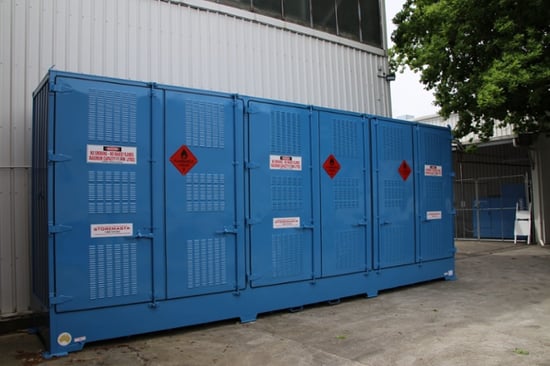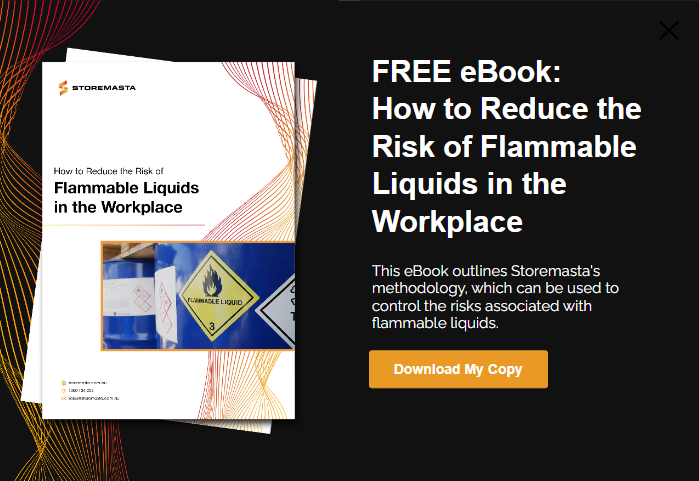Are you storing any type of flammable chemical? Whether it’s Class 3 Flammable Liquids, Class 2 Flammable Gases or Class 4.1 Flammable Solids, you must implement and maintain a series of control measures to reduce the risks that these chemicals pose to your business. And while each class has its own unique properties, hazards and incompatible substances, one thing these chemicals have in common is their ability to ignite and cause a devastating fire or explosion. If you’re carrying any type of flammable chemical at your worksite, read on to learn more about how to reduce risk when storing flammables in your business.
Storing Flammable Liquids
As defined by the Australian Dangerous Goods Code (ADG Code), flammable liquids are:
Flammable liquids are liquids, or mixtures of liquids, or liquids containing solids in solution or suspension (for example, paints, varnishes, lacquers, etc., but not including substances otherwise classified on account of their dangerous characteristics) which give off a flammable vapour at temperatures of not more than 60 °C, closed-cup test, or not more than 65.6 °C, open-cup test, normally referred to as the flash point. This class also includes:
(a) liquids offered for transport at temperatures at or above their flash point; and
(b) substances that are transported or offered for transport at elevated temperatures in a liquid state and which give off a flammable vapour at a temperature at or below the maximum transport temperature.
Due to the low flash point of flammable liquids, there is a high risk of fire or explosion if the flammable vapours meet an ignition source. There is also the risk of flammable liquids leaking or spilling, which can result in other incidences such as human harm and environmental damage.

The storage of flammable liquids must ensure that leaks and spills are adequately contained and managed.
There are several key storage requirements for flammable liquids — as detailed in the Australian Standard AS 1940:2017. We’ll focus on storing your flammable liquids in an indoor safety cabinet.
Cabinet construction must include the following:
- Double-walled sheet steel (walls, floor, doors and roof) with a 40 mm gap
- Materials critical to structural integrity mustn’t melt at temperatures below 850 °C.
- Sealed gaps around doors and walls
- Liquid-tight spill containment sump at least 150 mm deep
- All spills directed into the sump
- Perforated shelving
- Self-closing, close-fitting doors held shut automatically (by catches at 2 or more points)
While flammable cabinets are constructed from dual-skinned steel, with all gaps sealed to assist in fire protection, there may be the need for a ventilation system. If a ventilation system is installed on a flammable cabinet, the hazardous vapours must be dispersed to an outdoor location that’s isolated from ignition sources and places where people may congregate.
Larger Quantities Of Flammable Liquids
If you have large quantities of flammable liquids, we recommend choosing an outdoor store. The Standard dictates the quantities of flammable liquids that may be stored in an indoor location.
It explains that indoor storage cabinets must not be larger than 850 litres and no more than 850 litres of flammable liquids may be stored per 250m2 of floor space.
Outdoor chemical containers are often a more practical solution for businesses that carry large quantities of Class 3 chemicals. When selecting an outdoor store, look for one that is purpose-built for flammable liquids storage and is in full conformance with AS 1940:2017.
When storing larger quantities of flammable liquids, a relocatable outdoor chemical container constructed to meet the requirements of AS 1940:2017 is a cost-effective and compliant solution.
Outdoor flammable liquids stores offer unique features including cambered roof to assist with rain runoff, natural ventilation system of louvres, heavy-duty steel construction to minimise risk of impact damage and ISO locking bars to prevent the theft of Dangerous Goods.
IMPORTANT: When storing flammable liquids or any type of Dangerous Goods, it’s essential that staff are trained to follow strict procedures for their use and handling. Thorough housekeeping practices must also be implemented and maintained to ensure that chemical spills, hazardous vapours and any other hazards are corrected and controlled.
Storing Flammable Solids
The ADG Code provides us with this definition of Class 4.1 Flammable Solids:
Class 4 is divided into three divisions as follows: (a) Division 4.1 Flammable solids, Solids which, under conditions encountered in transport, are readily combustible or may cause or contribute to fire through friction; self-reactive substances which are liable to undergo a strongly exothermic reaction; solid desensitised explosives which may explode if not diluted sufficiently;
Flammable solids can spontaneously combust or can cause (or contribute) to a fire through friction. These Dangerous Goods also will emit flammable gases which are heavier than air and can accumulate in low lying places. If these gases meet an ignition source, they will easily ignite. As a volatile substance that can react with other Dangerous Goods classes, it’s crucial that Class 4.1 Dangerous Goods are stored in a compliant manner to minimise the risk of ignition, combustion and explosion.

Flammable solids are prone to spontaneous combustion if they’re not handled or stored in the correct manner.
The Australian Standard that relates to flammable solids is AS/NZS 5026-2012 – The storage and handling of class 4 dangerous goods.
Compliant flammable solids cabinets control risks through a series of features including:
- Double-walled sheet steel (walls, floor, doors and roof) with a 40 mm thermic air barrier
- Self-closing, close-fitting doors that release automatically with a build-up of pressure within the cabinet
- Perforated shelving to assist air flow
- Liquid-tight spill containment sump 150 mm deep
- Flash arrestors and vent openings (for ventilation systems)
A key factor in the storage of flammable solids is the ventilation of storage cabinets. The Standard explains that each cabinet or compartment shall be ventilated to conform with the requirements of set out in AS/NZS 5026.
5.7.5 Ventilation of cabinets
Where ventilation is installed the design of any vent opening in the cabinet wall shall not compromise the structural strength of the cabinet.
Where a toxic or flammable gas could be emitted, ducting shall be designed in such a manner as to prevent back-pressure and shall be directed away from ignition sources and areas where people congregate.
NOTE: ventilation provision should be designed by an appropriately qualified person.
A Class 4 DG ventilation system must comply with the requirements of AS/NZS -1668.2-2002.
Features must include:
- Ventilation system must ensure vapours don’t escape into the room
- Must be vented to the outdoors in a safe location away from ignition sources and places where people may congregate
- The ventilation system must not compromise the structural integrity of the cabinet
- The system can’t be linked to multiple cabinets as it could result in violent chemical reactions of incompatible vapours
- The air inlet of the ventilation system must be attached to the vet port at the top of the cabinet
- Vapours must be extracted from the bottom vent port via an exhaust fan
- The exhaust fan must be intrinsically safe
Storing Flammable Gases
The definition of Class 2.1 Flammable Gas is provided by the Globally Harmonised System of Classification and Labeling of Chemicals - otherwise known as GHS.
Section 3.1.2 of GHS states that:
Class 2.1 - Flammable Gas can be defined as gases at 20 °C and a standard temperature of 101.3 kPa are ignitable when in a mixture of 13% or less by volume in air.
The risks with flammable gases are due to the highly pressurised metal vessels that store the gas. There is the risk of asphyxiation (from hazardous gas leaks), human harm (from flying gas bottles), and fire or explosion (from gas meeting ignition sources).
Gas cylinders must be managed in the workplace as per the requirements of AS 4332:2004 - The storage and handling of gases in cylinders.
Compliant gas cylinder cages or stores must be constructed with:
- Non-combustible construction materials
- Level base to avoid cylinder instability
- Restraints and chains to prevent bottles falling over
- Doors that open outwards or have a ventilated roller door which can be opened from inside
The compliant storage of gas cylinders can be slightly different depending on the type of gas that you’re carrying. At STOREMASTA, we offer specially designed and constructed gas cylinder cages for the storage of acetylene, aerosols and LPG gas.
Flammable gases pose a range of risks to people and property, and must be stored correctly.
Due to the serious risk of flammable gases leaking or building up within a building, ventilation is a key consideration for organisations that carry this class of Dangerous Goods.
To ensure a safe working environment gas cylinder stores should ideally be situated in an outdoor location that allows for the dispersion of gases.
Mechanical ventilation may be installed if the levels of vapours or gases exceeds the standards set by the workplace exposure limits for airborne contaminants. Ventilation must also be at both high and low levels within the store, relative to the floor. This is to achieve a free flow of air within the store and the successful dissipation of harmful gases.
Key Considerations For Flammables
While the storage requirements for these flammable chemicals are very different, there are some basic guidelines that apply to all flammables in the workplace.
These include:
- The isolation of ignition sources
- Separation from incompatible substances
- Choosing a compliant location for your store
- Protection from impact damage
- Removal of any combustible materials near the stores
- Correct DG and safety signage on stores
- Adequate staff training on chemical safety and compliance
- Effective housekeeping procedures for stores
Safely Storing Flammables In The Workplace
How are you storing your flammable liquids, flammable solids or flammable gases? As we’ve highlighted in this blog, a safe and compliant store must consider a range of factors including a compliant storage solution, adequate ventilation, separation from incompatible chemicals and the isolation from any type of ignition source. If you’d like to learn more about working with Class 3 Dangerous Goods, we have an eBook that can help. How To Reduce The Risk Of Flammable Liquids In The Workplace is our easy-to-understand guide that will lead you through our 4-step risk control methodology, IDENTIFY – ASSESS – CONTROL – SUSTAIN. Access your free copy today to learn more about storing flammables safely.

Patrick Gee is Storemasta’s Content Creator and Marketer. With background in journalism, Patrick is passionate about using his communication and photography skills to help organisations find safe solutions for dangerous goods storage. His Instagram is filled with pictures of his dog Milo, along with his travels throughout Australia and overseas.


